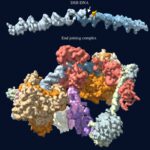Lien vers Pubmed [PMID] – 8473297
Lien vers HAL – Cliquez ici
J Biol Chem. 1993 Apr 25;268(12):8529-35.
The carboxyl-terminal catalytic domain of the human poly(ADP-ribose) polymerase (PARP) exhibits sequence homology with the NAD(P)(+)-dependent leucine and glutamate dehydrogenases. To clarify the role played by some conserved residues between PARP and NAD(P)(+)-dependent dehydrogenases, point mutations were introduced into the whole enzyme context. Non-conservative mutations of Lys-893 (K893I) and Asp-993 (D993A) completely inactivate human PARP, whereas conservative and nonconservative mutations of Asp-914 (D914E and D914A, respectively) and Lys-953 (K953R and K953I, respectively) partially alter PARP activity. The consequences of conservative substitution of Lys-893 and Asp-993 on the kinetic properties of human poly(ADP-ribose) polymerase enzyme and the polymer it synthesizes suggest that these 2 amino acids are directly involved in the covalent attachment of the first ADP-ribosyl residue from NAD+ onto the acceptor amino acid. In addition, the recent resolution of the three-dimensional structure of the NAD(+)-linked glutamate dehydrogenase from Clostridium symbiosum (Baker, P.J., Britton, K.L., Engel, P.C., Farrants, G.W., Lilley, K.S., Rice, D.W., and Stillman, T.J. (1992) Proteins 12, 75-86) strongly supports our alignment with leucine and glutamate dehydrogenases and provides an interesting structural framework for the analysis of our results of site-directed mutagenesis.

